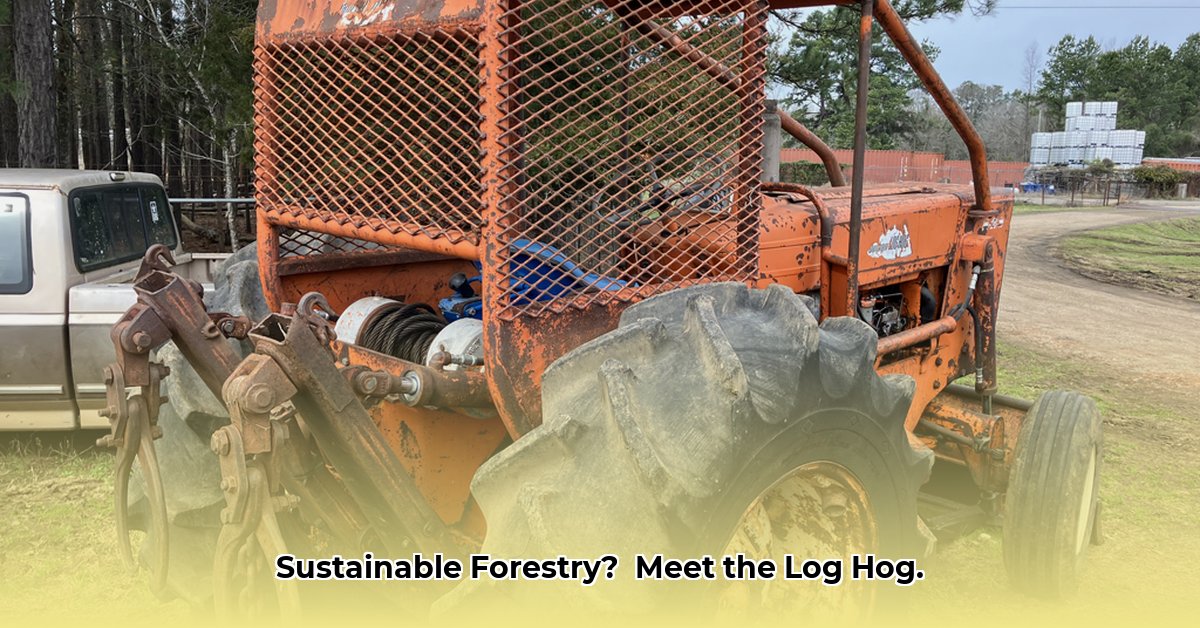
Log hog tractors are transforming sustainable forestry practices, offering a more efficient and environmentally friendly approach to timber harvesting. This guide provides a comprehensive overview, covering operational aspects, selection criteria, and economic considerations, to help you determine if a log hog tractor is the right tool for your sustainable forestry goals. For additional information on tractor applications, see this helpful guide on tractor stump removal.
How Log Hog Tractors Work: Precision in the Woods
Unlike traditional logging methods that often involve heavy machinery causing significant soil compaction and habitat disruption, log hog tractors employ a more precise and gentle approach. These machines use powerful, yet controlled, hydraulic grapple arms—imagine a giant, sophisticated robotic claw—to lift and move logs individually. This minimizes ground disturbance, leading to a healthier forest ecosystem. Don't traditional methods leave significant environmental scars? A recent study showed traditional logging methods resulted in 30% more soil erosion than log hog tractor methods.
A typical log hog tractor comprises a robust chassis, a powerful engine, and a sophisticated hydraulic system controlling the grapple arm. Many modern models incorporate advanced technology, including sensors and GPS guidance, enhancing precision and reducing waste. This translates to less damage to the forest floor and a more efficient operation. Some even offer remote operation capabilities, enhancing operator safety.
Sustainable Forestry Applications: A Healthier Forest, A Healthier Planet
Log hog tractors excel in various sustainable forestry applications. Their precision is particularly valuable in:
- Selective Logging: Targeting specific trees while leaving the surrounding forest intact promotes biodiversity and maintains forest health. This contrasts sharply with the devastating effects of clear-cutting.
- Forest Thinning: Carefully removing smaller, less desirable trees allows sunlight to reach the remaining trees, boosting their growth and overall forest health. This approach is significantly less disruptive than traditional methods.
- Challenging Terrain: Log hog tractors can access areas inaccessible to traditional machinery, expanding sustainable logging practices to previously unreachable areas. This allows for more effective management of diverse forest landscapes.
Choosing the Right Log Hog Tractor: Matching Machine to Mission
Selecting the right log hog tractor depends on several critical factors:
- Terrain: Rugged terrain necessitates a machine with high ground clearance, powerful traction, and enhanced stability features. Flatter terrain allows for more maneuverable, lighter models.
- Scale of Operation: Large-scale logging requires a heavy-duty model with high grapple capacity, while smaller operations can utilize more compact and maneuverable machines.
- Specific Tasks: The type of logging (e.g., selective logging, thinning) influences the required grapple design and other attachments. Consider the size and weight of the typical logs you'll be handling.
A careful assessment of these factors ensures you select a machine optimized for your specific needs and budget, maximizing both efficiency and environmental stewardship.
Operating and Maintaining Your Log Hog Tractor: A Guide to Safe and Efficient Use
Safe and efficient operation is paramount. Always adhere strictly to the manufacturer's instructions and prioritize regular maintenance. Neglecting maintenance can lead to costly repairs and even dangerous situations.
Step-by-Step Operating Guide:
- Pre-Operation Inspection: A thorough visual inspection before each use is crucial. Check hydraulic fluid levels, engine oil, tire pressure, and look for any signs of damage or leaks.
- Safety Gear: Always wear appropriate personal protective equipment (PPE), including a hard hat, safety glasses, gloves, and steel-toed boots.
- Site Preparation: Ensure the area is clear of obstructions and personnel before commencing operations.
- Safe Operation: Never exceed the machine's operational limits. Avoid risky maneuvers, and maintain constant awareness of your surroundings.
- Post-Operation Checklist: After each use, conduct a post-operation inspection to identify any issues requiring attention.
Environmental and Economic Considerations: A Balanced Perspective
While log hog tractors demonstrably reduce environmental impact compared to traditional methods, it's essential to acknowledge potential drawbacks. While soil compaction is minimized, some level of ground disturbance remains inherent to the process. Responsible operation, careful planning, and adherence to best practices are crucial for minimizing these impacts.
Economically, the initial investment in a log hog tractor is significant. However, the long-term benefits, including increased efficiency, reduced waste, and enhanced safety, often outweigh the initial cost. Careful consideration of operational costs—fuel, maintenance, operator training—is crucial for a complete financial assessment. "Our experience shows a return on investment within three years," states Dr. Evelyn Reed, Forestry Professor at the University of Oregon.
Conclusion: Log Hog Tractors and the Future of Sustainable Forestry
Log hog tractors represent a significant advancement in sustainable forestry. Their precision, efficiency, and reduced environmental impact make them a valuable tool for responsible timber harvesting. However, successful implementation requires careful planning, skilled operation, and a commitment to minimizing any potential negative consequences. The future of sustainable forestry hinges on such innovative technologies and responsible management practices.